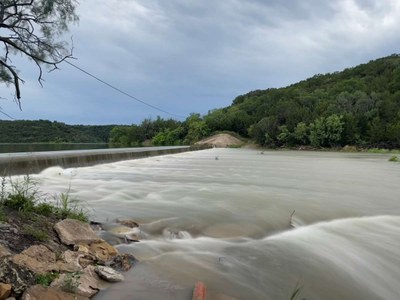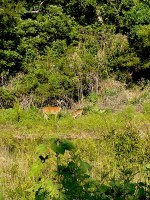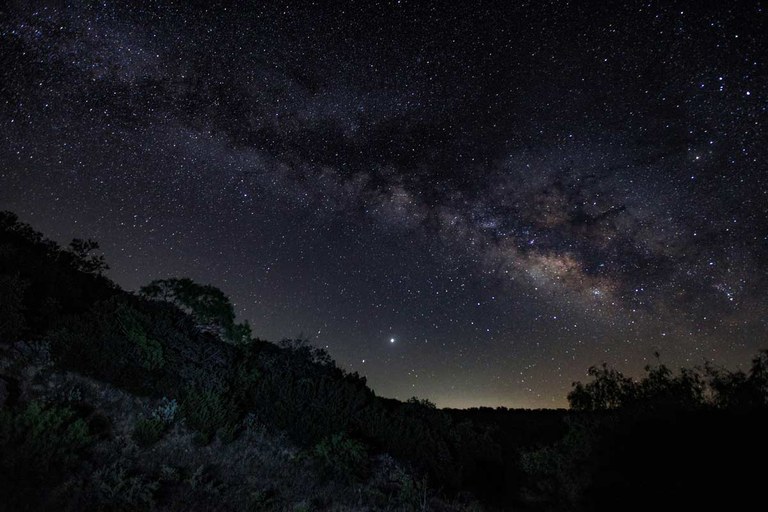Managing Natural Resources
September 2024
 By Ranger Kate
By Ranger Kate
 Is it fall already? Or is this just false fall? Hmm, at the very least, summer vacation has come to an end for a lot of folks. Even if the Texas sun doesn’t think so. With this break in the heat, we’ve gotten a significant amount of rain: nearly 8 inches in one weekend!
Is it fall already? Or is this just false fall? Hmm, at the very least, summer vacation has come to an end for a lot of folks. Even if the Texas sun doesn’t think so. With this break in the heat, we’ve gotten a significant amount of rain: nearly 8 inches in one weekend!
But work hasn’t stopped at the park. A lot goes into managing a park, even one that’s closed for construction. In addition to building gorgeous facilities for Texans to enjoy, our team also plays an important role in managing and conserving our natural resources.
Five main tools are used in wildlife management: plow, cow, gun, axe and fire. Overuse or complete removal of these tools can damage ecosystems. But if used in moderation and carefully watched, these same tools can be the exact things that restore healthy ecosystems and maintain thriving wildlife populations.
Spotlight Surveys
 Over the next couple of months, rangers will be working with our regional natural resource specialist to gather data on the number of deer in the park using spotlight surveys.
Over the next couple of months, rangers will be working with our regional natural resource specialist to gather data on the number of deer in the park using spotlight surveys.
Deer play an important role in the ecosystem, especially in managing plant species by eating overgrowth and spreading seeds. Too many deer could result in overgrazing. Not enough deer means that plant populations could become unbalanced.
The information we get from our surveys will help guide our efforts to manage our deer herd.
Prescribed Burns
In a few months, we will be working with the Wildland Fire Program of TPWD’s State Parks Division to conduct prescribed burns.
Before settlers arrived, fires happened naturally. They kept fast growing plants at bay (looking at you, mesquite!) and stimulated seed germination of various trees and grasses.
However, more settlement meant fewer fires. This resulted in the loss of plant varieties and an increase in ground fuel. Ground fuel is made up of layers of dried leaves, grasses and twigs that create excellent kindling, feeding very hot and fast-moving wildfires in summer months.
Prescribed burns help prevent wildfires. Prescribed burns are mapped out ahead of time, closely monitored to keep flames low (almost to a crawl), and monitored for days afterwards to avoid rekindling. These fires reduce ground fuel build-up (and wildfires) and encourage the return of key plant species.
Dark Sky Protection
 For several months (and for several months to come), our rangers have been taking dark sky readings to determine our Bortle rating. A Bortle rating is based on the darkness of our sky at night, how easily we can see the Milky Way with the naked eye, and how much light pollution affects our park.
For several months (and for several months to come), our rangers have been taking dark sky readings to determine our Bortle rating. A Bortle rating is based on the darkness of our sky at night, how easily we can see the Milky Way with the naked eye, and how much light pollution affects our park.
Light pollution is any artificial light that disrupts the light and dark cycle of a regular 24-hour period. Disruption of these cycles can affect wildlife and humans alike. It confuses birds and pollinators during annual migrations and prevents us from enjoying the beauty of a starry night sky.
We hope to become certified as an International Dark Sky Park. This identifies our park as having exceptional night sky viewing and recognizes the steps we take to protect the light and dark cycles. One of those steps is installing lights that shield our night sky from light pollution.
Learn more about Dark Skies and the effects of light pollution.
Natural Balance
There really are a lot of moving pieces to balancing recreation and protection of natural resources. Some areas of pocket prairies are not mowed so that wildflowers can reseed and animals have shelter from the summer heat. Some waterways do not allow certain types of access because of sensitive organisms that support the environment. Some trails don’t allow dogs to avoid scaring important wildlife.
Texas State Parks’ rules and regulations allow access to an amazing array of public lands while also preserving those lands for future generations to enjoy. I hope the next time you visit one of our parks, you take time to appreciate the work that goes into restoring and maintaining healthy ecosystems.
